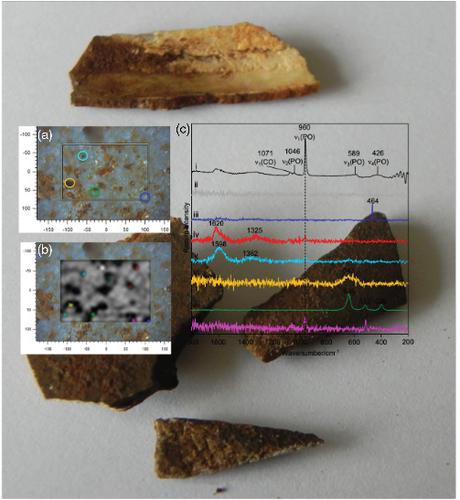当前位置:
X-MOL 学术
›
J. Raman Spectrosc.
›
论文详情
Our official English website, www.x-mol.net, welcomes your
feedback! (Note: you will need to create a separate account there.)
Raman spectroscopic and elemental analysis of bone from a prehistoric ancestor: Mrs Ples from the Sterkfontein cave
Journal of Raman Spectroscopy ( IF 2.4 ) Pub Date : 2021-08-17 , DOI: 10.1002/jrs.6226 Howell G. M. Edwards 1 , Elizabeth A. Carter 2 , Sarah J. Kelloway 2 , Karen L. Privat 3 , Thérèse M. Harrison 2
Journal of Raman Spectroscopy ( IF 2.4 ) Pub Date : 2021-08-17 , DOI: 10.1002/jrs.6226 Howell G. M. Edwards 1 , Elizabeth A. Carter 2 , Sarah J. Kelloway 2 , Karen L. Privat 3 , Thérèse M. Harrison 2
Affiliation

|
The complementary value of analytical elemental and molecular data for archaeological relics recovered from a burial deposition is illustrated here with the non-destructive analysis of bone specimens from an early human ancestor, known as Mrs Ples. Discovered in 1947 by Robert Broom in the Sterkfontein Cave system, forming part of the Cradle of Humankind in Gauteng Province, South Africa, a skull from Australopithecus africanus dated to 2.1 Mya has been identified as a Hominidae precursor to Homo sapiens. The ability to record novel compositional and structural data from such specimens without any form of chemical or mechanical pretreatment is fundamentally necessary for the preservation of such unique relics while affording conservators the information needed to undertake restoration and the adoption of conservation strategies. Our analyses revealed information about the state of preservation of the samples as well as their depositional context. Raman microspectroscopic mapping produced data on the spatial distribution of phosphate, quartz, carbon, calcite and manganese dioxide signatures on the bone fragments. Extensive deposits of pyrolusite, manganese(II) oxide, on the bone specimens are attributed to hydrogeological processes from ground water irrigation of the skeletal remains in the depositional environment; the identification of distinct quartz- and calcite-rich areas may arise from taphonomic and/or depositional processes. Raman spectroscopic signatures of the organic proteinaceous component of the prehistoric bone are not observed, indicating the degradation of endogenous organics or, if present, were masked by exogeneous materials. The identification of carbon could additionally reflect the remains of biodegradative processes that have operated in the burial site. Elemental mapping using X-ray fluorescence and variable pressure scanning electron microscopy imaging and spatially resolved energy dispersive X-ray spectroscopy provided complementary information about the samples. The result is a comprehensive characterisation of the samples' morphology, elemental and molecular composition from the micro scale to the macroscale, using entirely non-destructive analytical techniques.
中文翻译:

史前祖先骨骼的拉曼光谱和元素分析:来自 Sterkfontein 洞穴的 Ples 夫人
从墓葬沉积物中恢复的考古遗迹的分析元素和分子数据的补充价值在这里通过对早期人类祖先(称为Ples 夫人)的骨骼标本的无损分析来说明。罗伯特·布鲁姆于 1947 年在 Sterkfontein 洞穴系统中发现,该洞穴系统是南非豪登省人类摇篮的一部分,来自非洲南方古猿的头骨可追溯到 2.1 Mya,已被确定为人类科智人的前身. 能够在没有任何形式的化学或机械预处理的情况下记录此类标本的新成分和结构数据,对于保存此类独特的文物,同时为保护人员提供进行修复和采用保护策略所需的信息,是必不可少的。我们的分析揭示了有关样品保存状态及其沉积背景的信息。拉曼显微光谱绘图产生了关于磷酸盐、石英、碳、方解石和二氧化锰特征在骨碎片上的空间分布的数据。骨骼标本上大量软锰矿、氧化锰 (II) 的沉积归因于沉积环境中骨骼遗骸的地下水灌溉的水文地质过程;发现不同的富含石英和方解石的区域可能来自埋藏和/或沉积过程。未观察到史前骨骼的有机蛋白质成分的拉曼光谱特征,表明内源性有机物的降解,或者如果存在,则被外源性材料掩盖。碳的鉴定还可以反映在墓地进行的生物降解过程的残留物。使用 X 射线荧光和可变压力扫描电子显微镜成像和空间分辨能量色散 X 射线光谱的元素映射提供了有关样品的补充信息。结果是从微观尺度到宏观尺度对样品形态、元素和分子组成的全面表征,
更新日期:2021-08-17
中文翻译:

史前祖先骨骼的拉曼光谱和元素分析:来自 Sterkfontein 洞穴的 Ples 夫人
从墓葬沉积物中恢复的考古遗迹的分析元素和分子数据的补充价值在这里通过对早期人类祖先(称为Ples 夫人)的骨骼标本的无损分析来说明。罗伯特·布鲁姆于 1947 年在 Sterkfontein 洞穴系统中发现,该洞穴系统是南非豪登省人类摇篮的一部分,来自非洲南方古猿的头骨可追溯到 2.1 Mya,已被确定为人类科智人的前身. 能够在没有任何形式的化学或机械预处理的情况下记录此类标本的新成分和结构数据,对于保存此类独特的文物,同时为保护人员提供进行修复和采用保护策略所需的信息,是必不可少的。我们的分析揭示了有关样品保存状态及其沉积背景的信息。拉曼显微光谱绘图产生了关于磷酸盐、石英、碳、方解石和二氧化锰特征在骨碎片上的空间分布的数据。骨骼标本上大量软锰矿、氧化锰 (II) 的沉积归因于沉积环境中骨骼遗骸的地下水灌溉的水文地质过程;发现不同的富含石英和方解石的区域可能来自埋藏和/或沉积过程。未观察到史前骨骼的有机蛋白质成分的拉曼光谱特征,表明内源性有机物的降解,或者如果存在,则被外源性材料掩盖。碳的鉴定还可以反映在墓地进行的生物降解过程的残留物。使用 X 射线荧光和可变压力扫描电子显微镜成像和空间分辨能量色散 X 射线光谱的元素映射提供了有关样品的补充信息。结果是从微观尺度到宏观尺度对样品形态、元素和分子组成的全面表征,











































 京公网安备 11010802027423号
京公网安备 11010802027423号